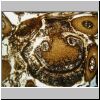 |
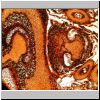 |
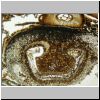 |
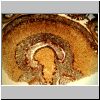
|
In practically every transverse section of a stem of Tempskya
a petiole is starting or departing. The process is as follows: first the
xylem strand is getting thinner at departure and bending outward. Than the
petiole comes off together with a C-shaped piece of the xylem of the stem.
In the xylem of the stem an opening remains which is closing soon above the
departure of the petiole.
The xylem of a petiole is always C-shaped.
Beyond about 1 mm outside the stem the petioles stop to exist, except within
the reach of the exterior of the trunk. This explains the scarseness of loose
petioles in the transverse section of the trunk.
Free petioles are sometimes called leaf bases or phyllopodia. In a specimen of Tempskya from Tasmania a lot of phyllopodia are present, just before the departure from the trunk. The top row of photos comes from this specimen. The diameter of these full-grown petioles is about 3 mms. The decaying petioles from the bottom row have an average diameter 1 mm.
Click at the photo to enlarge
 |
 |
 |

|
In the fossil of a tree fern from the Lower Jurassic of Tasmania are
several petioles. The photos below are from this specimen. So this is not
a Tempskya, but a 'normal' tree fern. However, the structure
of these petioles is comparable with those of Tempskya.
The name of the fossil is Osmundacaulis pruchnickii and it is
one of the eight species so far described from the genus
Osmundacaulis. They have all be found in the Lune River Flora in
Tasmanië. (With thanks to Ross Jones)
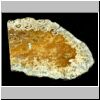 |
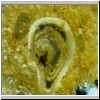 |
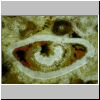 |
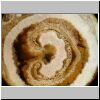 |